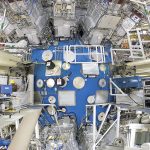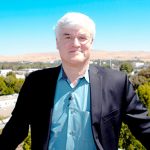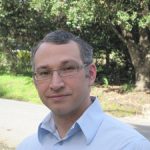Exceeding Fusion Fuel Breakeven
Lasers at The National Ignition Facility
Speakers from the National Ignition Facility & Lawrence Livermore Laboratory
Sponsored by The Policy Studies Organization
In Cooperation with the American Public University
About the Lecture
 The long sought-after goal of capturing the power source of the stars has been elusive. Fusion scientists have worked for decades on a series of increasingly advanced machines to create the conditions to initiate a self-sustaining fusion burn.
The long sought-after goal of capturing the power source of the stars has been elusive. Fusion scientists have worked for decades on a series of increasingly advanced machines to create the conditions to initiate a self-sustaining fusion burn.
In one such approach, inertially confined fusion, conditions similar to those at the center of the sun are created using powerful lasers, focused on container of deuterium (D) and tritium (T). If the plasma created by the lasers can be confined for a sufficiently long period of time causing DT fusion reactions, self-heating caused by the alpha particles from the fusion reactions will accelerate until the process runs away and the plasma ignites in a self-sustaining burn. Of course, achieving this state is not easy!
In this talk, we will discuss the science, technology, and progress towards ignition on the National Ignition Facility (NIF) at Lawrence Livermore National Laboratory. In attempts to create ignition on NIF, the DT fuel is contained in a BB sized capsule which is imploded and compressed in volume by the lasers by a factor of ~40,000. To be successful the implosion must remain highly spherical, which is extremely challenging.
During this talk we will cover some of the setbacks encountered during the progress of the research at NIF, and some exciting recent advances. In particular, we will cover work using the new “high-foot” pulse-shape implosion that presently holds the record for fusion performance on the NIF. High-foot implosions are the first facility based fusion experiments to generate more energy from fusion than was invested in the fusion fuel. In these experiments, the yield was amplified by the alpha-particle self-heating process by more than ~2X. While much needs to be done to reach ignition, these new results are encouraging.
About the Speaker
 PENROSE (“PARNEY”) ALBRIGHT served as Director of the Lawrence Livermore National Laboratory (LLNL) from 2011 to 2013. Before becoming Director he was Principal Associate Director for Global Security at LLNL. Prior to joining LLNL he served as President of the Civitas Group. Before joining Civita he served as Assistant Secretary for Science and Technology at the Department of Homeland Security, a role he took on after serving concurrently as Assistant Director for Homeland and National Security in the White House OSTP and as Senior Director for Research and Development in the Office of Homeland Security. Earlier in his career, Parney worked at DARPA and took on a variety of assignments at the Institute for Defense Analysis.
PENROSE (“PARNEY”) ALBRIGHT served as Director of the Lawrence Livermore National Laboratory (LLNL) from 2011 to 2013. Before becoming Director he was Principal Associate Director for Global Security at LLNL. Prior to joining LLNL he served as President of the Civitas Group. Before joining Civita he served as Assistant Secretary for Science and Technology at the Department of Homeland Security, a role he took on after serving concurrently as Assistant Director for Homeland and National Security in the White House OSTP and as Senior Director for Research and Development in the Office of Homeland Security. Earlier in his career, Parney worked at DARPA and took on a variety of assignments at the Institute for Defense Analysis.
Parney has been involved in the security arena since 1986. He led planning for the science and technology enterprise as the Department of Homeland Security was being formed. He served as principal advisor to the Secretary of DHS and the Executive Office of the President for security-related science and technology, particularly relating to explosives and CBRN threats. He was he architect of the DHS R&D and counter-CBRN enterprise and formulated the National Homeland Security RDT&E.
Parney earned a BS in Physics and Applied Mathematics from GWU and a PhD in Physics from U Md.
 JOHN EDWARDS is Associate Director of the National Ignition Facility (NIF) at LLNL, where he is Director for Inertial Confinement Fusion and High Energy Density Science (HEDS) and leader of the Inertial Confinement Fusion Program. He is responsible for directing the x-ray drive ignition effort. Prior to joining LLNL, John was a group leader for the High Energy Research and Alternate Concepts at the Atomic Weapons Establishment in the United Kingdom.
JOHN EDWARDS is Associate Director of the National Ignition Facility (NIF) at LLNL, where he is Director for Inertial Confinement Fusion and High Energy Density Science (HEDS) and leader of the Inertial Confinement Fusion Program. He is responsible for directing the x-ray drive ignition effort. Prior to joining LLNL, John was a group leader for the High Energy Research and Alternate Concepts at the Atomic Weapons Establishment in the United Kingdom.
John is a Fellow of the American Physical Society. He is an author on over 100 journal publications.
He earned a BSc is Physics and Astrophysics from U. Birmingham in the UK and a PhD from Imperial College, London.
 OMAR HURRICANE is a Distinguished Member of the Technical Staff at LLNL and lead scientist for the High-foot Implosion Campaign on NIF. His research is focused primarily on high energy density physics science, plasma instability, and weapons physics.
OMAR HURRICANE is a Distinguished Member of the Technical Staff at LLNL and lead scientist for the High-foot Implosion Campaign on NIF. His research is focused primarily on high energy density physics science, plasma instability, and weapons physics.
Among numerous awards, he is the recipient of DOE’s Ernest Orlando Lawrence Award for National Security and Nonproliferation, DOE Defense Programs Recognition of Excellence Awards, and three LLNL Directors’ Science & Technology. He is the author of 60 journal publications and another 60 conference papers.
Omar earned a BS Physics and Applied Mathematics from the Metropolitan State University of Denver, and an MS and PhD from UCLA.
Minutes
President Larry Millstein called the 2331st meeting to order on March 21, 2014 at 8:22 pm. He announced the order of business, and talked about the 5th meeting of the Society held in 1871. The topics were the elements of motion of the "Comet 1, 1871", more information about a chronograph which could measure down to intervals of a millisecond, and a presentation about the construction of Brooklyn Bridge. After the introduction of new members, minutes from the previous lecture were read and approved. The President then introduced the speakers for the evening, Dr. Parney Albright, Dr. John Edwards and Dr. Omar Hurricane.
Dr. Albright introduced the National Ignition Facility, NIF, the largest laser facility on the planet. It is an impressive feat of engineering, with a footprint the size of several football fields, housing 192 laser beams passing through 60000 control points with thousands of optical elements bearing 523 TW of power, capable of delivering 1.875 MJ of energy. The NIF was built for several missions, including enabling nuclear stockpile stewardship, advancing nuclear science and making weapons safer without requiring live nuclear tests. The NIF also conducts frontier science by duplicating temperatures and energy densities existing only in stars, cores of gas giants and in an operating nuclear weapon. Dr. Albright described nuclear weapon operation to point out that NIF uniquely allows experiments to duplicate and study each stage of this process. He also pointed out that many of these experiments would be the same to study energy generation by fusion.
While the NIF programs cover many physics areas, Dr. Albright indicated that this lecture would be focused on "ignition," defined as obtaining more energy from a fusion reaction than the energy put in.
Dr. Albright then turned the podium over to Dr. Edwards, who started by describing the very high level of control required over positioning and timing to achieve ignition. Dr. Edwards showed a video of the 192-beam laser system in operation. Each 20 ns-long pulse of red light, amplified, beam-shaped and converted to blue, must simultaneously arrive at the Hohlraum target in the containment chamber to deliver 1.8 MJ of energy. About 70% of this is converted into X-rays. More is lost to heat and escaping X-rays. 0.15 MJ of energy goes into compressing the target capsule. About 12 kJ is delivered to the fuel inside the capsule, but very recently, NIF ignition experiments obtained 27 kJ of energy from the fusion process triggered this way. This is a very exciting result.
Successful fusion, Dr. Edwards stated, requires extreme machines capable of confining material to very high densities with extreme pressure. The best example is the Sun. Its confinement is provided by gravity and is very stable. Its center has about 250 billion atmospheres of pressure with infinite confinement time. In the 1950s, we developed magnetic confinement in tokamaks, with single-atmosphere levels of pressure and seconds of confinement time. The system in the NIF depends on "inertial confinement," with the pressure close to 300 billion atmospheres and confinement time around 0.1 ns.
The target fusion reaction at the NIF is the deuterium-tritium (DT) reaction. These isotopes have a tendency to fuse, if they are pushed together with a force enough to overcome their electrostatic repulsion. This requires temperatures as high as 50 megaKelvin. The fusion products are a helium ion and a neutron. The neutron flies out without interacting with anything. Fusion energy scientists try to capture it to generate heat by its energy. The helium ion, that is to say the alpha particle, is the interesting output for ignition. If its energy can be captured in the DT plasma, it can heat the plasma itself up more, increasing reaction rate. This positive feedback is required for ignition.
Dr. Edwards described the critical parameter for feedback, "rho-R"---the density of the plasma times its size. We need high rho-R to recapture the alpha particle's energy within the hot spot and use it to push the reaction further. For a high rho-R, we can either increase the density or the size. The preferred method is to keep the same number of particles and increase the density by compression until the rho-R factor is close to 1. The plasma then needs to be heated up to around 50 MK, which can use up the energy requirements of an average household in a year. If less material is used, compressed smaller, less energy is necessary. The experiments in the NIF require compression from the solar density DT (0.25 g/cc) to about 1000 g/cc. The burn starts in the hot spot in the middle of the target capsule. In a successful experiment, the material contained in this spot, 0.1 mm across, would yield the same amount of energy as one kg of coal. The NIF experiments are about halfway to this goal.
Dr. Edwards then described the facility which enables very high precision in delivering the energy of 192 laser beams into a single mm3 sized target for the required high compression. High energy density capacitors start the laser beam generation. Each beam is amplified through warehouse-size laser amplifiers of large slabs of neodymium-glass, rolled and shaped with special techniques which had to be developed during the construction of the facility. By the time the beams reach the target chamber, which was installed in 1999, the intensity of the light that runs through the final stage optics is 10 J/cm2, which is extremely high. The optics and wavelength converters were therefore also specially developed to handle this level of intensity, which is beyond what was possible anywhere else at the time. The target chamber is about a sphere about 10 meters across, and it has to stay stable down to about 25 micrometers.
The target is also an engineering marvel. To start compression, the target capsule is cooled to the freezing point of helium, around 17 K, with silicon cooling arms. This already achieves compression by a factor of about 10000. Extra microheaters are mounted around to control temperature down to mK of uniformity. Special shrouds fitting around the target preserve the very cold temperature.
Dr. Edwards then introduced Dr. Hurricane to describe how the ignition experiments are run. Dr. Hurricane started with the preparatory experiments which precede the full ignition experiments, such as re-emit experiments which examine the radiation patterns on the surface of the target capsule, shock-timing experiments to shape the laser pulse shaping, symcap experiments to reveal the hot-spot shape forming in the target, and other experiments about how the target shell is going to respond to the excitation. These are all necessary to set up the full DT shot with the maximum chance of success.
The trick for ignition is to turn 100M atmospheres of pressure to 300 billion atmospheres. The energy required for ignition scales inversely with the stagnation pressure, therefore extreme pressures are desired.
The target capsule is shaped like a hollow sphere, with an outside ablator layer about 195 micrometers thick, coated on the inside with a layer of DT ice about 69 micrometers thick. The Hohlraum target, about a cm long, is blasted by the laser beams, which are converted to a bath of x-rays inside the target's metal shell, which in turn causes the surface of the capsule to explode. The tiny target size limits the amount of energy absorbed. This initial explosion creates about 100 million atm of pressure, which causes the outside of the capsule to be driven inwards like a spherical rocket. The fuel on the inside of the capsule is accelerated to velocities around 370 km/sec. About 14 kJ of kinetic energy is delivered to the fuel. Ideally all this kinetic energy can be transferred into a final implosion, forming a hot spot from the cold fuel around it, with about 300 B atmospheres of pressure. The NIF experiments have reached about 180 B atmospheres so far.
The 2-mm diameter capsule has a plastic (C-H) ablator layer, covered on the inside with a very thin layer of silicon dopant, which protects the inside of the capsule from high-energy x-rays and pre-emptive heating. On the very inside, there is an about 70- to 100-micron thick layer of DT, the cold fuel. The plastic ignition capsule needs to be as smooth and round as possible and requires very high precision manufacturing. When the 2-mm diameter target is compressed with the x-rays which come out of the Hohlraum, it is squeezed into a hot spot that is less than 100 micrometers across, or compressed about 35 times. The kg of coal worth of energy mentioned before is coming out of this 100 micrometer-sized spot, within 1/7th of one nanosecond.
Dr. Hurricane showed implosion simulations, which demonstrate how the process works and potential problems. Such work was instrumental in designing the laser pulse timing and shaping. The fusion yield increased dramatically in late 2013. Dr. Hurricane believed that directly trying for an extreme implosion initially had led to a lot of misses. A new strategy adopted by the NIF scientists was to aim for a smaller but more controlled implosion. Two implosions within 2014 yielded more fusion energy than was delivered to the fuel and demonstrated a much higher level of feedback in the form of alpha particles from the fuel self-heating the fuel itself.
A specific new technique was to change the laser pulse shape, from what was called the "low-foot" pulse to a "high-foot" pulse. The implosions triggered by the low-foot pulse was causing the capsule surface to tear itself apart, while the high-foot pulse allows a more controlled implosion, with reduced instability. The trade-offs are an increase in entropy, and somewhat reduced compression.
One aim is to achieve a more round implosion shape. Current high-foot implosions have a toroidal shape. Ongoing work such as changing the hohlraum material from gold to uranium has helped, increasing the fusion yield about 1.5 times between 2013 and 2014.
Dr. Hurricane summarized that shifting from low-foot to high-foot implosions has increased yield at the cost of some compression. The increased control allowed the NIF program to now turn up the laser energy, recovering some of the compression, and reach the alpha-heating dominated regime: Now the fusion reaction is helping itself by leaving heat behind and heating itself up.
Dr. Hurricane likened the NIF approach to a mountain-climbing strategy, by planning and setting up a path of base camps, each progressively higher. The paths are to increase the velocity of the imploding shell, to improve the hot-spot shape control, to lower the entropy back and create higher ablation pressure. The key issues that have to be addressed are instability, implosion shape control, higher implosion speeds and higher compression. Having passed the threshold for fusion alpha-particle self-heating has allowed the NIF to increase the yield by more than twice, and obtain more energy out of the DT fuel than the amount of ignition energy that had reached the DT fuel.
The president then invited questions. One question was whether the platinum or palladium were ever tested as fuel instead of DT. Dr. Hurricane responded that high-atomic number materials radiate energy away very quickly and the necessary heating feedback would not form.
Another question was on the debris left behind after the ignition shots. Dr. Edwards remarked that after a few shots, the vaporized debris would coat the optics inside the chamber, and models have been developed to account for the change in optical characteristics. Disposable optics are also in use.
Afterwards Mr. President thanked the speakers, made the usual housekeeping announcements and invited guests to join the Society. At 10:10 PM, President Millstein adjourned the 2331st meeting to the social hour
Attendance: 76
The weather: Scattered Clouds
The temperature: 9°C
Respectfully submitted,
Zeynep Dilli
External Communications Director